Recently published in Nature, a paper written by Dr. Xueyan Feng on soft-matter double gyroids has gained great attention! The full article from Rice university can be seen here. Abstract of the paper from Nature can be found here.
All posts by ys50
Thomas group awarded with Safety Award
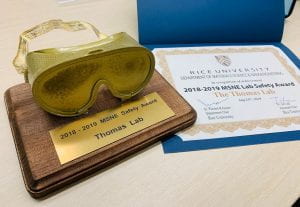
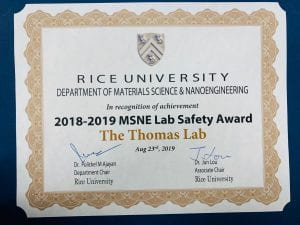
Thomas group was awarded with MSNE Lab Safety Award for 2018 – 2019 academic year. The award ceremony took place on September 25th at 1:15pm at Vahalla. Congratulation to Thomas group for the high recognition of lab safety.
Happy Birthday to Dr.Pavel
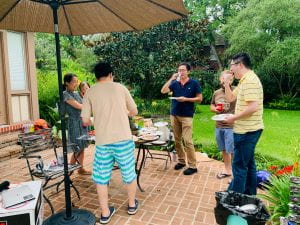

Thomas group members had barbecue pool party at Dr.Pavel’s home to celebrate his birthday. See more pictures in group photos section.
Group Meeting with Dr. Wenpeng Shan
Thomas group had a group meeting on June 21st to welcome new postdoc in the group, Dr. Wenpeng Shan.
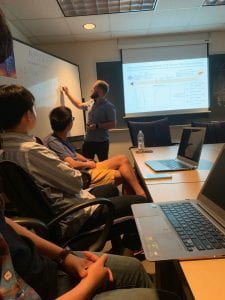
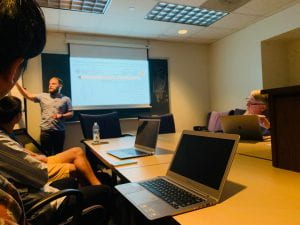
Dr. Wenpeng Shan

Dr. Wenpeng Shan joined the Prof. Thomas’ group in June 2019. He received his Ph.D at University of Akron in 2018 under the supervision of Prof. Stephen Z. D. Cheng, then spent one year in South China Advanced Institute for Soft Matter Science and Technology as research associate. His research interests focus on characterization of self-assembled block copolymers with various architectures.
Amanda Suarez
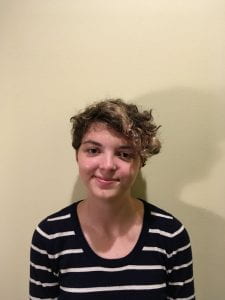
Amanda Suarez is an undergraduate student at Rice and joined the lab in 2019. Her research interest is in block copolymer assembly, grain boundaries and structural defects.
Morphology and Properties of Block Polymers with Cyclic-linear Architectures
Shaping Symmetry and Molding Morphology of Triply-Periodic Network Assemblies via Molecular Design of Block Copolymers
Shaping Symmetry and Molding Morphology of Triply-Periodic Network Assemblies via Molecular Design of Block Copolymers [DOEnergy Project]
The goal of the research is to advance a new paradigm for the molecular design of block copolymer (BCP) architectures that specifically target triply-periodic network (TPN) assemblies with precisely tailored morphologies at the sub-unit cell scale. The aim is to uncover the “molecular design rules” that underlie an unprecedented level of morphological control of TPN assembly:
1) Tailorable molecular designs that target and achieve equilibrium assembly of TPN symmetries beyond just the common gyroid phase.
2) Unprecedented control over the intra-unit cell compositions of stable TPN (i.e. tunable ratios of channel/inter-channel domain volumes)
Block polymers self-assemble into network phases at conditions intermediate to cylindrical and lamellar (stacked sheet) morphologies. At present, the symmetries and topologies of TPN structures formed by BCP are largely limited to a specific class of ‘gyroid’ structures (i.e. tubular domains interconnected in 3-fold junctions). This research advances a new hypothesis about the role of tailored elastic asymmetry in multiblock architectures in the thermodynamics of TPN assembly.
Structures of Defects and Interfaces in Block Copolymer Materials
Structures of Defects and Interfaces in Block Copolymer Materials [NSF Project]
The detailed structure of defects in soft materials like polymers has received relatively little attention compared to the vast literature on defects in hard crystalline materials (metals, ceramics and semiconductors), where high-resolution electron microscopy and other techniques have quantitatively imaged the new arrangements of the atoms caused by the various kinds of defects, thus enabling a very detailed understanding of the key role of surface, line, and point defects on controlling important material properties such as mechanical strength and electrical conductivity. In this lab, current research provides valuable data for comparison to theoretical simulations of the morphology of microdomain interface morphology in A-B diblock copolymers where the interplay of minimization of interfacial area between the A and B domains vs. chain stretching within the respective domains controls the shape of the interface. Additionally, we will extend and verify microscopy techniques to explore the 3D nature of grain boundary and line defects that can frequently occur in technologically important diblock structures and can limit their performance.
Bongki Shin

Bongki Shin is a professional master student at RICE and joined the group in 2018 Fall. His project is to use the laser-induced projectile impact test (LIPIT) to launch micron sized projectiles with high velocities into various polymer thin films in order to understand the extreme deformation at nano and micro-scale processes and study how the nanostructure dissipates the impact energy.